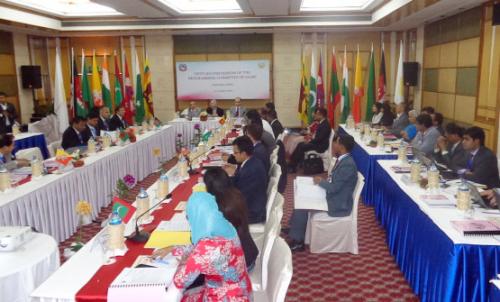
Here again with a SAARC Meeting or better as journalists and insiders call it, a mini SAARC meeting. It is a mini because this time only the Ministers of Foreign Affairs will meet in lakeside town of Pokhara.
A prep meeting of the Joint Secretaries of the member nations clearing the ground for the summit is currently underway.
With an agenda not less than “ambitious”, covering all the issues that were discussed in Kathmandu during the last meeting of the Heads of State in 2014, no one should be surprised that in reality the expectations out of this mini summit are actually kept at minimum.
What else should come out from a regional body that is consistently relegated on the backburner by the political leaders of the member states who lack the political will to push forward the process of regional integration?
While there are many reasons why this is happening, primarily the fact that all the Heads of Government and States are fully immersed in dealing with their national level politics, none of them is grasping the fact that, investing politically in the process of regional integration, could actually help them solve many of their problems wrongly confined within the perspectives of their respective national borders.
Instead, it would be very important for the leaders of South Asia, while thinking about their priorities, to zoom out and think long term and find the farsightedness to frame their daily challenges, be it political instability, caste discrimination and fight against poverty though the lens of a regional cooperation.
In order to do able to find the strength and political will to invest their energies in the process of regional integration, I would like to suggest three ideas that could help them.
Number 1: The SAARC leaders should meet more often.
Despite these days experiencing one of its most difficult time, the European Union is the most advance example of regional integration.
One of its key elements is the fact that the Heads of State of the member nations meet very often within the European Council, a specifically set up political body supporting their discussions and negotiations with meetings twice every semester but in realities happening much more often, whenever the situations require them.
Certainly the same frequency of meetings could not apply in a context like South Asia but the SAARC Leaders should at least meet once every year to start with. The current practice of having their meeting only once every two year (if we are lucky) does not bring any fruits.
Moreover and tactically very important, the Foreign Ministers should be find the time to meet at least once every six months. The organization of these meetings like the one now undergoing in Pokhara could rotate among the member states in order to share all the related logistical burdens.
These meetings should be void of much formalities and glamour and be instead organized as “standard” working gatherings among peers with a certain level of informality with a focus on dealing with practical working items.
Number two: Let’s create a parliamentarian dimension of the SAARC
The Leaders should allow the members of the national parliaments to meet and familiarize among themselves. Again the benchmark is the European Union with an elected parliament that over the years has gained considerable clout. We all know that this is neither possible nor practical in our region.
Then for example, why not allowing the members of the foreign affairs committees of each national parliament to meet once in year to discuss the actions taken by the Heads of State? While the European Parliament has a veto power in many but not all the decision makings, we should simply be happy in our case to have an SAARC Assembly of national MPs to provide non banding resolutions or recommendations. Progressively like it happened in Europe, the power of this inter parliamentarian institution could be enhanced and made stronger.
Number three: Support to the “regional” civil society.
probably the easiest among the suggestions: let’s keep alive the spirit of regional cooperation with more people to people events. The so called People’s SAARC, an event that is supposed to offer an opportunity to discuss regional issues among members of the so called civil society of the member nations, normally brought back to life every two year or whenever the big SAARC gathering happens, has a huge potential.
While such set ups will never be truly democratically representative of the citizens of the region and risk to remain more a conclave of intellectuals and members of the national elites, still they offer the best hope to keep the hopes for a deeper regional integration alive.
The SAARC Secretariat, itself in need of a real leader at its helm, possibly a former prime minister of a member state able to ensure the financial resources necessary to create a cadet of regional administrative officials in charge of the executing the decisions taken by the Heads of State, should play a much more proactive role to support people to people relationships in the region.
From a regional student exchange program to a regional volunteering service to more exchanges in the field of academics, there is plenty of untapped opportunities to reinvigorate the regional dynamics.
Interesting enough the only body within SAARC that is really working and it is effective is the SAIEVEC, South Asia Initiative to End Violence Against Children , a truly gem of regional cooperation thanks to the sheer will of its founding Director General, Dr. Rinchen Chophel. A pity that too few are aware of it.








7d88.png?itok=KI18yp23)

Add new comment